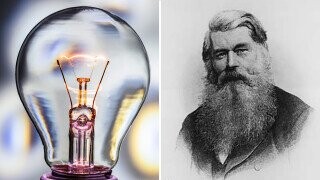12 Inventions That Were Accidentally Invented Twice

Nowadays, with the internet allowing for the instantaneous sharing of news, information, and death threats across the globe, scientists and inventors generally have a pretty good idea what everybody else is working on. In the past, though, it was more common than you might think, even with extremely well-known and influential inventions, for somebody else in a different country to be cracking the exact same problem at almost the exact same time. Scientists refer to it as “multiple independent discovery,” and it usually ends up with one of the two names being the one that gets written down in most history books. Here are 12 inventions that were so nice, they were invented twice.
The Lightning Rod
The lightning rod was invented by Benjamin Franklin, a man as famous for being obsessed with lightning as he is for having hilariously tiny glasses. In what is now the Czech Republic, though, an inventor named Prokop Divis had independently designed a grounded lightning rod that was actually MORE effective than Benjamin Franklin’s. Plus he probably didn’t fly a kite in a thunderstorm like an idiot.
Electromagnetic Induction
The idea of electromagnetic induction, which we still see frequently today in everything from rich people’s stovetops to wireless phone chargers, was unintentionally tag-teamed by Michael Faraday in England and American physicist Joseph Henry. It’s also probably slowly cooking us all from the inside out in a way we’re not medically advanced enough to figure out, but we’ll let later generations worry about that!
Chloroform

Chloroform was independently synthesized by three different inventors across the world at the same time, all of whom, I assume, were huge creeps. Samuel Guthrie, Eugene Soubeiran, and Justus Von Liebig all invented the knockout juice without communication, and spy movies were changed forever as a result. To this day, it’s one of the chemicals that’s most famously associated with a dirty rag.
The Telegraph
Samuel Morse built a working telegraph around the year 1835, and would later go on to become the namesake of Morse code, used to communicate by ships and by hostages in thriller movies. At the same time, Charles Wheatstone was patenting an early telegraph across the pond in Britain.
Bessemer Process
The Bessemer process, a method of purifying steel using air that had massive ramifications for the Industrial Age, was first invented in 1851 by a man named William Kelly. If you have a sharp eye, you may notice that the name William Kelly is notably, not named William Bessemer. The guy who somehow snuck in 4 years later, patented the process, and slapped his name on it? That was English inventor, and probably a name that’s not welcome around the Kelly family dinner table, Henry Bessemer.
Sound Film
In 1922, Polish scientist Joseph Tykocinski-Tykociner would debut the world’s first ever example of a “talkie” with a short film in which the audience could hear a bell ring. Strangely, his version wasn’t especially well-received, while in America, Lee De Forest would develop a sound-on-film technology known as Phonofilm, and eventually, with similar technology, the film “The Jazz Singer” would change movies forever, and set the stage for James Cameron to make 5 Avatar movies for some reason.
The Jet Engine

It seems that right around the year 1940, the universe had decided that the people of earth needed the jet engine ASAP. The jet engine would be invented THREE TIMES over three years, globe-hopping the whole way like the planes its invention would allow. First was in 1939 in Germany, by engineer and absolute mouthful of a name Hans Joachim Pabst von Ohain. In 1940, Italian engineer Secondo Campini would produce his take, and finally, in Britain, Frank Whittle and his dope-ass eyebrows would produce his version of the jet engine in 1941.
The Integrated Circuit
In 1959, while working at graphing calculator monolith Texas Instruments, Jack Kilby invented the world’s first integrated circuit, the father of the modern microchip. The indoor kids of the word have his little postage-stamp sized invention to thank for their Marios, and he was recognized with a Nobel prize in the year 2000. Robert Noyce also invented the integrated circuit… 4 months after Kilby. He has zero Nobel Prizes. It would be even more of a bummer if Noyce didn’t go on to found a small computing company called Intel.
The Telephone
In 1876, Alexander Graham Bell filed a patent for the telephone, unwittingly setting into motion a series of events that would eventually bring us TikTok. He wasn’t the only one to attempt to file a patent for the telephone though, as inventor Elisha Gray not only attempted to file the patent himself, but got into a long legal battle with Bell over who actually invented it.
The Light Bulb

Most 6th graders can probably tell you that Thomas Edison invented the incandescent light bulb, right before security comes and escorts you off the playground for asking kids weird questions. However, the same year that Edison patented his light bulb, an English physicist named Joseph Swan patented his own incandescent light bulb, greatly similar to Edison’s.
The Phonograph
Another Thomas Edison special was the phonograph, invented in 1877, which enabled ancient people to dance to the absolute worst version of a song you’d ever heard. At the same time, though, French inventor Charles Cros had written a paper theorizing the ability to record sound onto a glass disc, which was incredibly similar to the phonograph, though he never produced a working model.
The Mobius Strip
“Who invented the Mobius strip” might sound like a trick question designed to knock somebody out of the early rounds of a game show, but it’s a little more complicated than that. August Ferdinand Mobius may have gotten the name credit, but Johann Benedict Listing independently theorized the same shape and top 10 notebook doodle at almost the exact same time.
Top Image: Pixabay/Public Domain